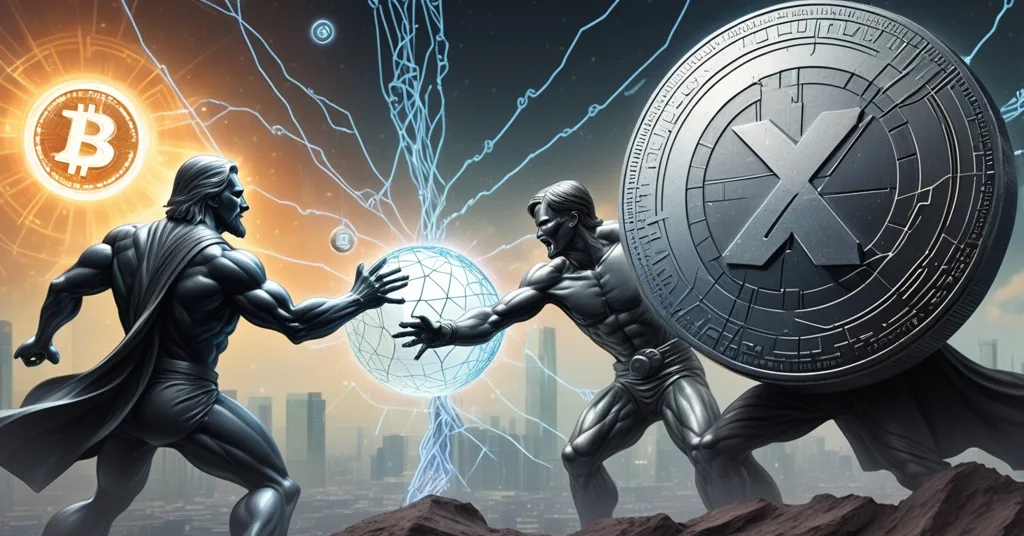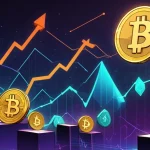XRP vs. Bitcoin Solaris: Which Crypto Investment Wins in 2025?

XRP vs. Bitcoin Solaris: Which Crypto Deserves Your Investment in 2025?
Navigating the crypto market in 2025 is like walking a tightrope between proven players with battle scars and shiny new projects promising the moon. On one side, we’ve got XRP, a decade-old coin tied to cross-border payments but bogged down by legal drama. On the other, Bitcoin Solaris (BTC-S), a presale newcomer hyping Bitcoin-level returns with tech that sounds almost too good to be true. Let’s slice through the noise and figure out which, if either, is worth your hard-earned cash.
- XRP’s Burden: A veteran with real-world use, slowed by SEC lawsuits and aging tech, offering modest growth at best.
- Bitcoin Solaris Buzz: A presale project claiming over 10,000 transactions per second, mobile mining, and a potential 150% return pre-launch.
- Risk Spectrum: Stability with XRP versus speculative hype with BTC-S—where’s the real value?
XRP: The Scarred Veteran of Cross-Border Payments
XRP, backed by Ripple, has been a staple in the crypto scene since 2012, carving out a niche as a fast, cheap solution for international money transfers. Its network facilitates cross-border payments for major financial institutions—think partnerships with players like MoneyGram and Santander—positioning it as a bridge between traditional finance and digital assets. Transactions settle in seconds for pennies, a stark contrast to Bitcoin’s sluggish pace and high fees for everyday use. On paper, XRP’s real-world utility is undeniable, handling significant transaction volumes through RippleNet, though exact numbers are often opaque due to Ripple’s tight-lipped reporting. For a deeper dive into its mechanics, you can explore more about XRP and the XRP Ledger.
But here’s the rub: XRP’s been in a regulatory cage match with the U.S. Securities and Exchange Commission (SEC) since 2020. The SEC alleges that Ripple’s $728 million in institutional sales of XRP were unregistered securities offerings. A partial victory came in July 2023 when a court ruled that XRP itself isn’t a security on public exchanges, but institutional sales violated securities laws—a $125 million penalty followed. Fast forward to October 2024, and the SEC appealed, dragging the saga into 2025. This legal limbo has tanked investor confidence, keeping XRP’s price growth sluggish. Even bullish forecasts for 2025 hover around modest gains, nowhere near the stratospheric returns of Bitcoin’s early days. For the latest on this ongoing battle, check out these XRP SEC lawsuit updates.
Yet, there’s a potential plot twist. With the Trump administration’s influence in 2025, the SEC’s leadership has shifted. Gary Gensler is out, replaced by Acting Chairman Mark Uyeda, who’s called past crypto policies a “disaster for the industry.” Incoming SEC Chairman nominee Paul Atkins pushes for clear guidelines over punitive enforcement, and a Crypto Task Force under Hester Peirce signals a softer stance. Senators like Cynthia Lummis and Tim Scott are also advocating to end aggressive actions against projects like Ripple. If the SEC pauses or settles the case, XRP could see a surge in market sentiment, shaking off its “stagnant” label. But banking on regulatory mercy is a dice roll, and XRP’s centralized undertones—Ripple controls a significant chunk of nodes and holds a massive pre-mined supply—clash with the decentralization ethos many of us hold dear. If you’re wondering about its future potential, there are community discussions on whether XRP is a solid investment for 2025.
Then there’s the tech angle. XRP’s infrastructure, while innovative a decade ago, feels dated compared to newer blockchains boasting scalability and smart contract capabilities. It’s stuck in a payments niche, lacking the DeFi or NFT ecosystems that drive hype for competitors like Ethereum or Solana. For Bitcoin maximalists, XRP’s utility is a double-edged sword—it serves a purpose Bitcoin doesn’t aim to, but its corporate vibe and legal baggage make it a lukewarm bet for explosive growth. Could a regulatory win spark life into this flatliner, or is it doomed to be the crypto equivalent of watching grass grow? To see how it stacks up, take a look at this comparison of XRP against newer cryptocurrencies.
Bitcoin Solaris: Hype Machine or Hidden Gem?
Now let’s turn to Bitcoin Solaris (BTC-S), a presale project pitching itself as the heir to Bitcoin’s throne with a modern edge. Currently in phase 10 at $10 per token, it’s set to jump to $11 in the next round with a launch target of $20, dangling a tempting 150% return before hitting exchanges. The project claims to have raised over $6 million with more than 13,650 users onboard, branding itself as one of the fastest-moving presales of the year. With just weeks left until launch—though timelines are murky, with some sources pointing to a July debut that may or may not have passed—the urgency is palpable for early speculators. For an overview of the project, here’s a detailed Bitcoin Solaris project review.
What’s fueling the buzz? BTC-S boasts a dual-layer architecture blending energy-efficient Proof-of-Work (PoW) and Delegated Proof-of-Stake (DPoS). For the uninitiated, PoW is the mining system Bitcoin uses, secure but energy-hungry, while DPoS lets token holders vote for a small group of validators to secure the network, slashing energy use and boosting speed. This hybrid setup supposedly delivers over 10,000 transactions per second (TPS) with two-second finality—blazing fast compared to Bitcoin’s 7 TPS or Ethereum’s pre-merge 15-30 TPS. To put it in perspective, if Bitcoin is a small coffee shop line, BTC-S claims to be a stadium emptying out in seconds. It also offers programmable smart contracts for decentralized finance (DeFi), validator rotation to prevent centralization, and adaptive difficulty for mining stability. Curious about its presale legitimacy? Check out the audit details for Bitcoin Solaris presale by Cyberscope and Freshcoins.
One of its flashiest hooks is mobile mining via the upcoming Solaris Nova App. Unlike Bitcoin mining, which demands power-guzzling hardware, BTC-S aims to let users mine tokens on their phones, complete with gamification, real-time leaderboards, and a Mining Power Marketplace. Add to that community perks like daily mini-games for holders and a referral program—offering a 5% token bonus to both referrer and referee during presale—and BTC-S seems engineered for engagement. Credibility markers include passing audits by Cyberscope and Freshcoins, plus endorsements from influencers like Crypto Show. Post-launch, tokens will reportedly be delivered to popular wallets like Trust Wallet or MetaMask, easing onboarding for DeFi users. For community feedback on this feature, see the Reddit discussions on Bitcoin Solaris mobile mining.
But let’s slam on the brakes before we buy the hype. Presales are the Wild West of crypto—high risk, high reward, and often high on empty promises. That 150% pre-launch return? It’s speculative carnival barking, not a guarantee. Independent verification of BTC-S’s lofty claims, like that 10,000+ TPS or mobile mining feasibility, is nowhere to be found. Issues like battery drain or network costs for phone mining aren’t addressed, and details on the team, tokenomics, or post-launch plans are thin. Compared to Solana’s advertised 50,000 TPS on a live network, BTC-S’s numbers are just marketing until proven. Many presales fizzle out or rug-pull investors post-fundraise, and while audits and influencer nods add a veneer of trust, they’re not bulletproof. Unlike XRP’s public battle scars, BTC-S operates in a fog of project-provided info. Is this innovation or just another shiny scam? If you’re weighing its investment potential, here’s a perspective on whether Bitcoin Solaris offers a clearer path to high returns.
Market Context: Bullish Waves and Behavioral Traps
Zooming out, the crypto market’s mood in 2025 shapes how both XRP and BTC-S play out. If we’re riding a bull run, as sentiment suggests, presales like BTC-S thrive on FOMO—investors chase the “next 100x gem” with reckless abandon. Established coins like XRP, meanwhile, offer stability during downturns but lack the sizzle for overnight doubles. BTC-S positions itself as expanding Bitcoin’s legacy with scalability and accessibility, but without a live network to test, it’s a gamble on vaporware. XRP’s real-world use in payments keeps it grounded, yet its chart is less a rocket and more a stubborn flatline.
Investor psychology plays a huge role here. XRP holders are often diehards, sticking through legal hell because they believe in Ripple’s vision to remake global finance. BTC-S, conversely, courts thrill-seekers and early adopters lured by mobile mining and DeFi buzz. But hype is a dangerous drug—I’ve seen countless “next Bitcoins” crash, leaving bagholders cursing their greed. And XRP’s slow grind can test the patience of anyone chasing quick flips. In a space driven by volatility, are you betting on loyalty to a battered veteran or the seductive unknown?
Through a Bitcoin Maximalist Lens
As someone who leans Bitcoin maximalist, I’m skeptical of both contenders when measured against BTC’s core strengths—unrivaled security and true decentralization. XRP’s centralized model, with Ripple’s heavy influence over nodes and token supply, feels like a betrayal of the peer-to-peer ethos Bitcoin pioneered. It’s useful, sure, but it’s more corporate tool than financial freedom fighter. BTC-S, with its untested governance and presale opacity, doesn’t inspire confidence either. If it delivers on scalability and mobile access, it could fill a niche Bitcoin doesn’t—mass adoption through usability—but without proof, it’s just noise.
Bitcoin itself isn’t perfect; its 7 TPS and energy-intensive mining make it impractical for microtransactions or global scale without layers like Lightning Network. XRP tackles payments, and BTC-S claims to tackle speed, but neither matches Bitcoin’s proven resilience as a store of value. As a champion of disruption, I’m open to altcoins carving out roles in this financial revolution—Bitcoin can’t and shouldn’t do it all—but they must align with decentralization and freedom. Right now, XRP feels like a compromised middleman, and BTC-S a risky longshot. Where do they fit in the fight for a freer financial future?
Critical Questions for Crypto Investors
- Can XRP deliver explosive returns anytime soon?
Unlikely, given ongoing SEC battles and modest 2025 price predictions. However, a regulatory reprieve could ignite fresh interest, though it’s a waiting game. - Is Bitcoin Solaris’s tech as revolutionary as it claims?
The dual PoW/DPoS setup and 10,000+ TPS sound groundbreaking, but without independent testing or a live network, it’s pure speculation for now. - Should you dive into BTC-S’s presale for quick profits?
The 150% pre-launch potential tempts, but presales are a minefield—many fail or scam. Only risk what you can afford to lose. - Could XRP’s regulatory mess become a positive trigger?
Absolutely, if the SEC under new leadership settles or drops the case, XRP’s market sentiment could spike, offering a rare catalyst. - Does BTC-S pose a credible challenge to Bitcoin’s legacy?
Too early to judge. Promises of scalability and mobile mining are bold, but Bitcoin’s battle-tested security and decentralization remain unmatched. - Which suits a newcomer versus a crypto OG?
Newbies might start with XRP to grasp real-world utility with lower volatility; OGs could see BTC-S as a speculative punt if they’ve got throwaway capital.
The Bottom Line: No Easy Answers
Neither XRP nor Bitcoin Solaris is a slam dunk. XRP offers grounded utility in cross-border payments but drags under legal and centralization baggage, with growth that might bore thrill-seekers to tears—unless the SEC hands it a lifeline. BTC-S tempts with massive upside and tech innovation, but its unproven claims and presale risks scream caution; it’s crypto’s equivalent of a lottery ticket. For newcomers, XRP might be a safer sandbox to understand blockchain’s potential. For veterans, BTC-S could be a speculative sprinkle—if you’re willing to kiss your investment goodbye.
As a proponent of decentralization and effective accelerationism, I’m rooting for anything that shakes up the status quo and pushes financial freedom forward. But blind faith has no place here. XRP’s corporate shadow and BTC-S’s hype machine both fall short of Bitcoin’s pure ethos, though each could carve a niche if they play their cards right. Dig into the details yourself, weigh the risks, and stay sharp—crypto’s a jungle, and the only guarantees are volatility and the occasional rug pull. Will you back the scarred fighter or the untested prodigy? Choose wisely.



